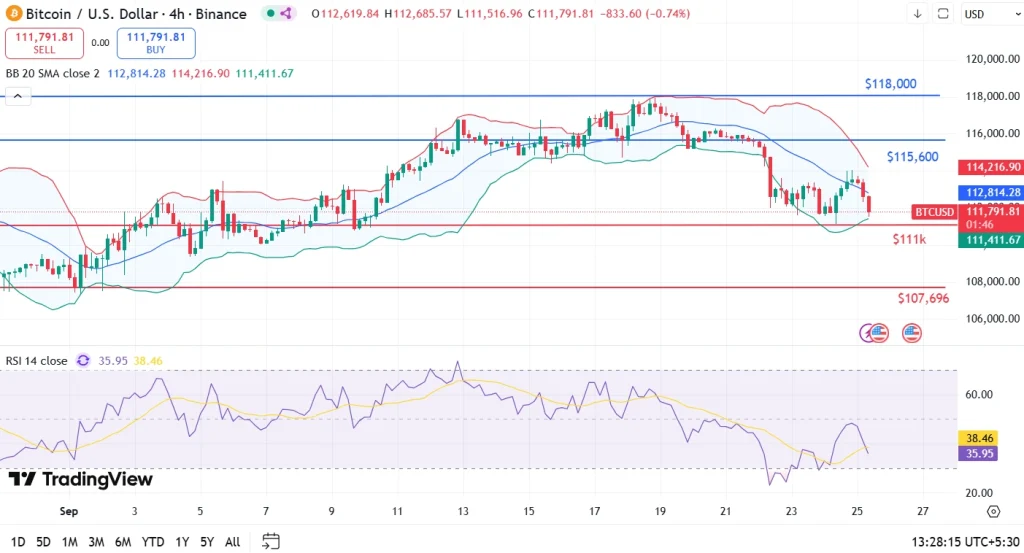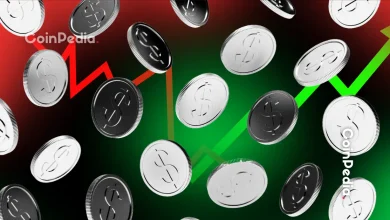
BTC price fell below $112k, now eyes $107–108K as next support zone
$1.7B long liquidation triggered a sharp sell-off, momentum remains weak
200-day EMA at $103,868 marks final technical line before deeper losses
Bitcoin’s price action is capturing traders’ attention after dropping below the crucial $112,000 mark. This has led to the burning question: how low can Bitcoin go? So, giving a brief overview, in the past 24 hours, BTC price slipped 0.56% to $111,872.56, extending a week-long slide. Growing volatility, heavy liquidations, and macroeconomic jitters have put downside pressure on prices. Let’s dig into the technical triggers, market sentiment, and the levels every trader should watch.
BTC Price Analysis
Bitcoin price broke a series of technical defenses in rapid succession. That being said, the 7-day SMA at $114,563, pivot point at $112,848, and the Fibonacci 38.2% retracement at $113,847 all failed to hold as support. This breakdown accelerated sell-offs as algorithmic traders triggered stop-losses just below $113,000, leading to a cascade that dragged BTC into the low $111,000s.

Volume has spiked 3.51% in the last 24 hours to $50.7 billion, signaling heightened activity. RSI at 35.95 suggests that there is no clear oversold bounce in sight. Funding rates have slipped into mildly negative territory, discouraging aggressive new longs and hinting caution among leveraged bulls.
- Also Read :
- Why ETH Is Going Down? How Low Can Ethereum Price Drop?
- ,
Key Levels to Watch
Given these conditions, the next immediate support rests at $111,000, followed by a key zone in the $107,000–$108,000 range. If panic selling intensifies, BTC price could test the 200-day EMA near $103,868, a level we view as the line in the sand. Any bounce is likely to face resistance at $113,000–$114,000, the zone that recently flipped from support to overhead pressure.
What Led To Bitcoin Price Drop?
Several factors have pushed Bitcoin lower. The most immediate driver was the $1.7 billion in long liquidations, which set off a chain reaction of forced selling and stop-loss triggers. Moreover, Fed Chair Jerome Powell reaffirmed a restrictive stance on monetary policy, weighing on risk assets across the board.
At the same time, President Trump’s renewed tariff threats stirred geopolitical uncertainty, tightening Bitcoin’s correlation with equities. Taken together, these catalysts have created an environment where traders are hesitant to step in aggressively, leaving Bitcoin vulnerable to further downside.
Never Miss a Beat in the Crypto World!
Stay ahead with breaking news, expert analysis, and real-time updates on the latest trends in Bitcoin, altcoins, DeFi, NFTs, and more.
FAQs
Bitcoin’s decline stems from technical breakdowns at multiple levels and a record $1.7 billion in long liquidations, making the sell-off sharper and faster.
Today’s drop is primarily due to massive long liquidations, hawkish Federal Reserve policy comments, and geopolitical uncertainty, which triggered a cascade of algorithmic selling.
In the next 24 hours, immediate support is at $111,000. A break below could push Bitcoin toward the $107,000-$108,000 range, depending on market sentiment.
Future price depends on macroeconomic policy from the Fed, shifts in leverage (funding rates), and whether institutional buyers return to provide support at key levels.
With an RSI near 36, Bitcoin is approaching oversold conditions, but negative funding rates suggest caution. For long-term investors, this could be an accumulation zone.
Trust with CoinPedia:
CoinPedia has been delivering accurate and timely cryptocurrency and blockchain updates since 2017. All content is created by our expert panel of analysts and journalists, following strict Editorial Guidelines based on E-E-A-T (Experience, Expertise, Authoritativeness, Trustworthiness). Every article is fact-checked against reputable sources to ensure accuracy, transparency, and reliability. Our review policy guarantees unbiased evaluations when recommending exchanges, platforms, or tools. We strive to provide timely updates about everything crypto & blockchain, right from startups to industry majors.
Investment Disclaimer:
All opinions and insights shared represent the author's own views on current market conditions. Please do your own research before making investment decisions. Neither the writer nor the publication assumes responsibility for your financial choices.
Sponsored and Advertisements:
Sponsored content and affiliate links may appear on our site. Advertisements are marked clearly, and our editorial content remains entirely independent from our ad partners.








